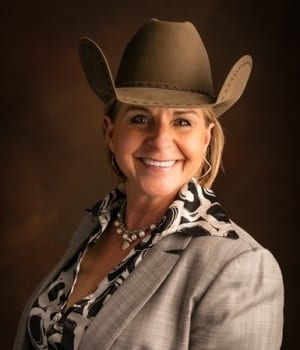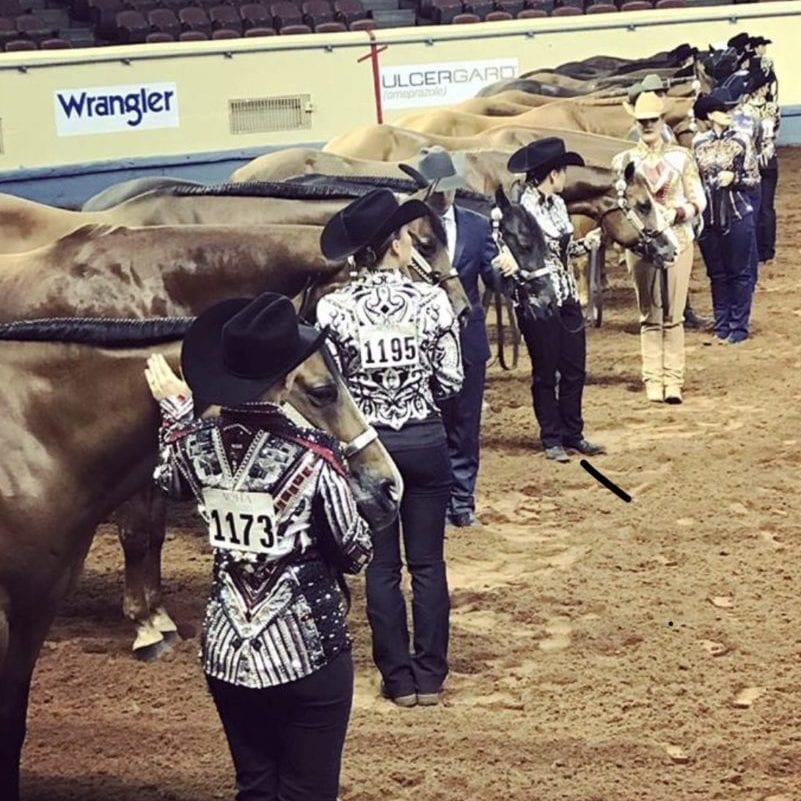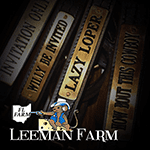The 2018 AQHYA World Show is well underway. The show runs from August 2-11 in Oklahoma City, Oklahoma. This event has youth from all over the world competing to claim the World Champion title and take home that special globe.
The World Show patterns are tough every year. The finals patterns are even more intense. This year, there is something new and different in the L3 14-18 Showmanship pattern. At the end of the pattern, the final maneuver asks to “line up side by side for further inspection.” For most youth exhibitors, this will probably be something they have never seen in a pattern.
We recently spoke with AQHA officials Justin Billings, Patti Carter and Karen McCuistion to gain a better understanding of this specific finals pattern and provide useful information for the exhibitors. These three professionals explained the roots of the showmanship class, the purpose of this maneuver and why it has been brought back to the show pen according to AQHA.
The Roots
 The showmanship class is judged on what it sounds like; being a good showman. Having control of every aspect of your horse and making him or her look their best are essential parts of this class. Patti Carter, AQHA Senior Director of Judges, went into detail on the history of this class to further understand why maneuvers are being brought back into play.
The showmanship class is judged on what it sounds like; being a good showman. Having control of every aspect of your horse and making him or her look their best are essential parts of this class. Patti Carter, AQHA Senior Director of Judges, went into detail on the history of this class to further understand why maneuvers are being brought back into play.
“The whole purpose of showmanship is to teach exhibitors how to show their horse at halter,” Carter said. “Set ups are important, straight lines are important, and all of the historical basics of the class are important. How connected you are to your horse is vital. Are you aware of where you are to your horse and where the judge is? All of those things go into play in the further inspection.”
Carter has drawn patterns for the World Show that are both exhibitor and judge-friendly. She is careful to make sure all the elements of the pattern are easily seen and can be judged fairly.
“The other thing that is very important in showmanship are the set ups,” Carter said. “Last year, when I started drawing the patterns, I started drawing the setups from a quarter turn, so the judges can see a set up from where they are sitting. A lot of times, when they are being set up head on, you can’t access the setup. By doing a quarter turn and having the setup on the profile, the judges can analyze the correctness of the set up. Set ups are significant to judges. It’s the basis of the class. Do you have good control of your horse’s feet? Do you have a plan? You need to be able to present your horse the right way. A quarter horse needs to stand correctly with all four feet underneath it. That set up is so important. That’s never changed throughout the history of the class.”
The Purpose
“The quarter system in the inspection is about safety,” Carter said. “Let’s say the farrier is working on the right hind foot. You would stand on that same side. If he moved over to the left hind foot, you would move over to that side. If he does the right front foot, you would be on the opposite side of the horse. It’s a safety thing. It’s the same thing if a veterinarian is working on your horse and you need to be on the correct side. It’s just to bring back the awareness of where you are supposed to be in relationship to your horse and the judge.”
 Karen McCuistion, Manager of the AQHA Professional Horseman, also believes bringing back elements like this will benefit and enhance the exhibitors’ skills.
Karen McCuistion, Manager of the AQHA Professional Horseman, also believes bringing back elements like this will benefit and enhance the exhibitors’ skills.
“I love the direction Patti is going, and I know she put a lot of thought into this,” McCuistion said. “I come from the hardcore, old-school route and I love it. As Patti said, the basis of the class was two phases. There was either safety or presenting your horse. You had to know where to be to be safe, and how to make your horse look its best. If you think about it, this helps whether you ever want to show in halter or whether you want to sell one. When you know where to put those feet and where that horse looks best, you’re going to make him or her look better for a buyer, or with anything else you are doing. It makes you a better horseman. I’m 120% for doing this.”
Carter described what will happen during the finals class this year. There are no tricks involved, and everything will be very straightforward. It is showmanship 101.
“When they are excused, they will line up side by side, tails to the rail along the edge of the arena,” Carter said. “They need to set their horse up and be in the correct position to the ring steward. We will tell them that they are showing to the ring steward and not to worry about the judges. They will be showing to that one person. After the class, the announcer will announce for the exhibitors to be prepared for further inspection. They will get a heads up, but they need to be ready and on the correct side of their horses. They need to be in the correct quadrant where they are supposed to be. It will be just a basic inspection similar to what was at the 2017 Amateur World Show. We aren’t throwing any curve balls at them this year. They might want to refresh their quadrants and practice having someone walk around, so this will give them a chance to have a heads up.”
 Showmanship is always one of the biggest classes at the AQHYA World Show. This year, the biggest class is the L2 Horsemanship with 162 entries followed by the L2 Showmanship with 161 entries. AQHA Manager of Shows, Justin Billings wants to ensure everyone is prepared for this finals pattern. AQHA will be having a Ride the Pattern clinic specifically for this pattern Saturday, August 4th following the last class in the Jim Norick Arena.
Showmanship is always one of the biggest classes at the AQHYA World Show. This year, the biggest class is the L2 Horsemanship with 162 entries followed by the L2 Showmanship with 161 entries. AQHA Manager of Shows, Justin Billings wants to ensure everyone is prepared for this finals pattern. AQHA will be having a Ride the Pattern clinic specifically for this pattern Saturday, August 4th following the last class in the Jim Norick Arena.
“We will touch on this topic in person with everyone,” Billings said. “We are going to have a free Ride the Pattern – Showmanship led by one of our Professional Horseman to share much of the same information Patti covers with the judges. It will be Saturday after all the classes have finished and also available live on AQHA’s Facebook page. If exhibitors want to find out more, they can come to the Ride the Pattern clinic or watch from home on Facebook with the live video.”
We also wanted to get perspective from a judge’s point of view. Jonathan Meilleur is one of the AQHYA World Show judges this year, and he is also an AQHA Professional Horseman. He thinks adding this element to the pattern is a great idea.
“I believe bringing back the line up will help personalize each exhibitor,” Meilleur said. “The presentation has become rote and mechanical. When a judge inspects every exhibitor in a lineup situation, it will truly demonstrate the understanding of where each showman should stand to present their horse to the judge best. No more just watching YouTube videos and imitating other showmanship exhibitors. The line up requires a real understanding of the quarter system.”
The Future
Bringing back “old school” elements like this might be seen more in upcoming years. Carter, Billings and McCuistion all agreed they want to continue implementing components to keep everyone at their best. The three of them believe this maneuver might be used at other shows down the road.
“I could see some of the judges incorporating this into their patterns for the throwback,” Billings said. “In today’s age, show managers are constantly looking for ways to speed the schedule along. They may view this as something that slows the show down, but there is some real merit in incorporating these elements for the reasons that Patti and Karen shared.”
“We will see if people grab hold of this and use it in the future,” Carter said. “I would like to eventually see the steward ask the exhibitors a question when they set up for inspection. Things like asking them to explain where the canon bone is on a horse, where the frog is or questions like that.”
Be sure to check out the Ride the Pattern clinic in person or on Facebook live tomorrow night. It will be a tremendous educational opportunity for all exhibitors and trainers. Good luck to all the finalists!
About the Author: GoHorseShow writer, Courtney Hall is a graduate student at Missouri State University. She is obtaining a Master of Science in Agriculture degree with research in agricultural communications. She started showing the APHA & AQHA all-around circuit as a youth and continues today as an amateur.









